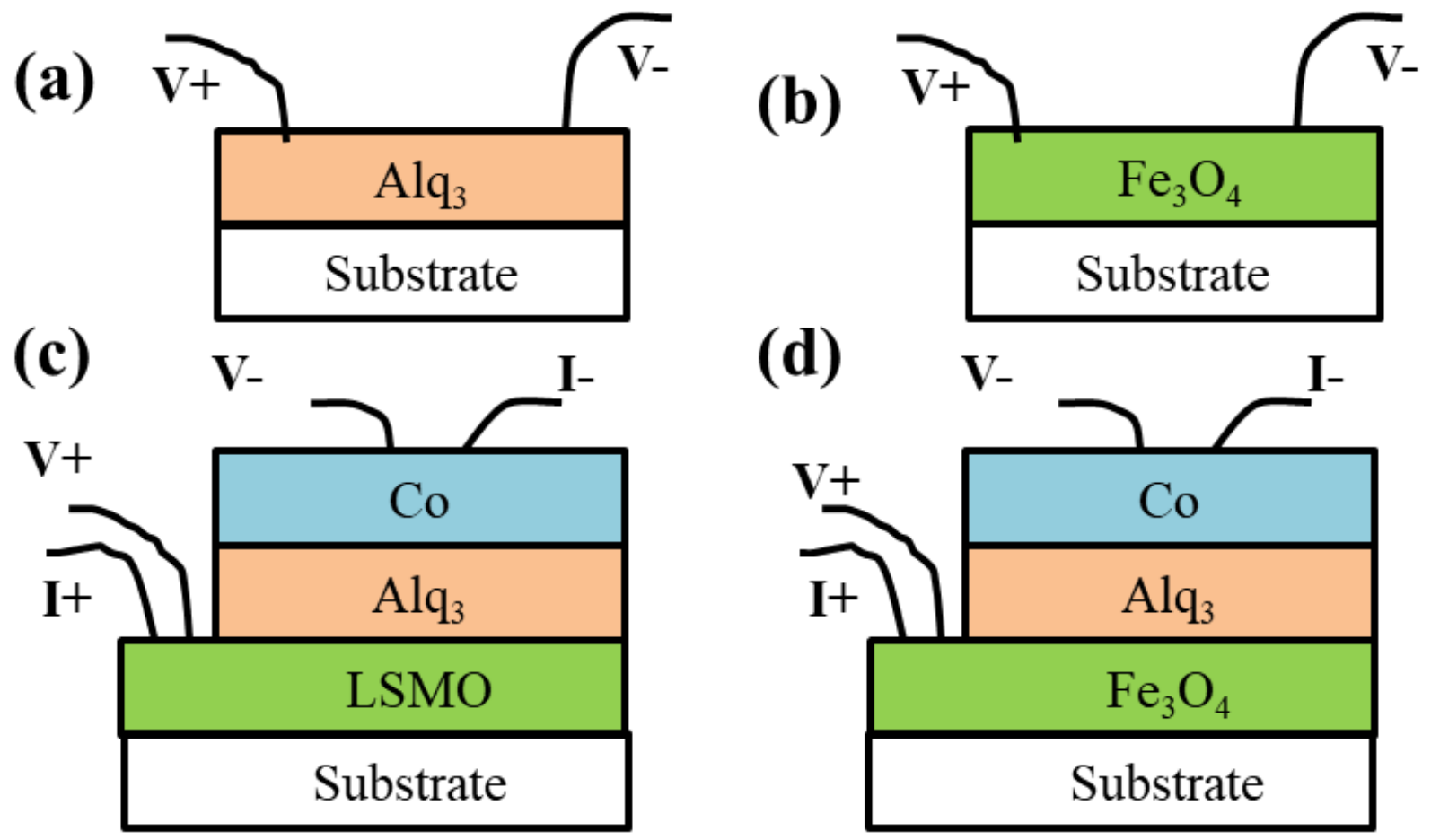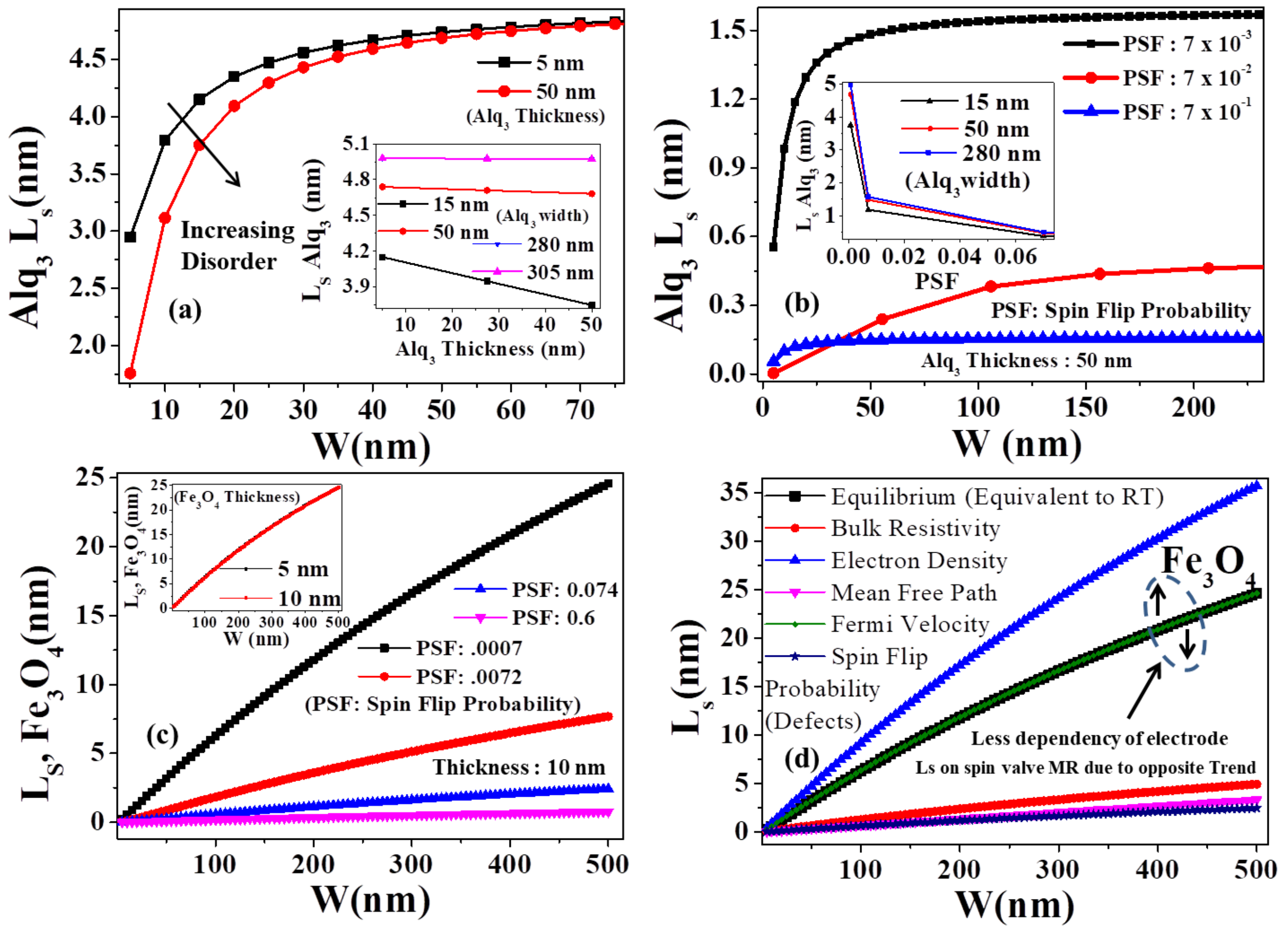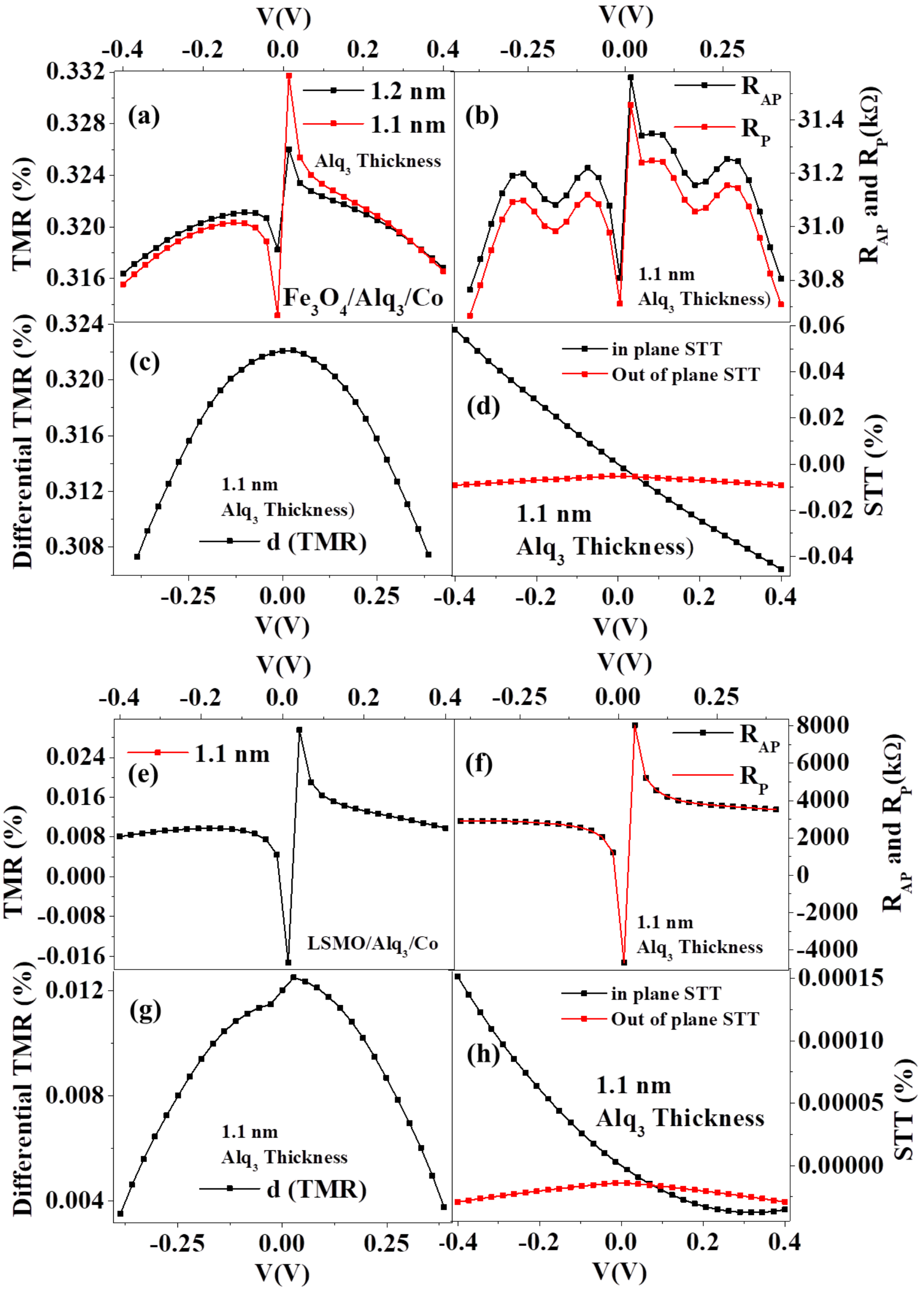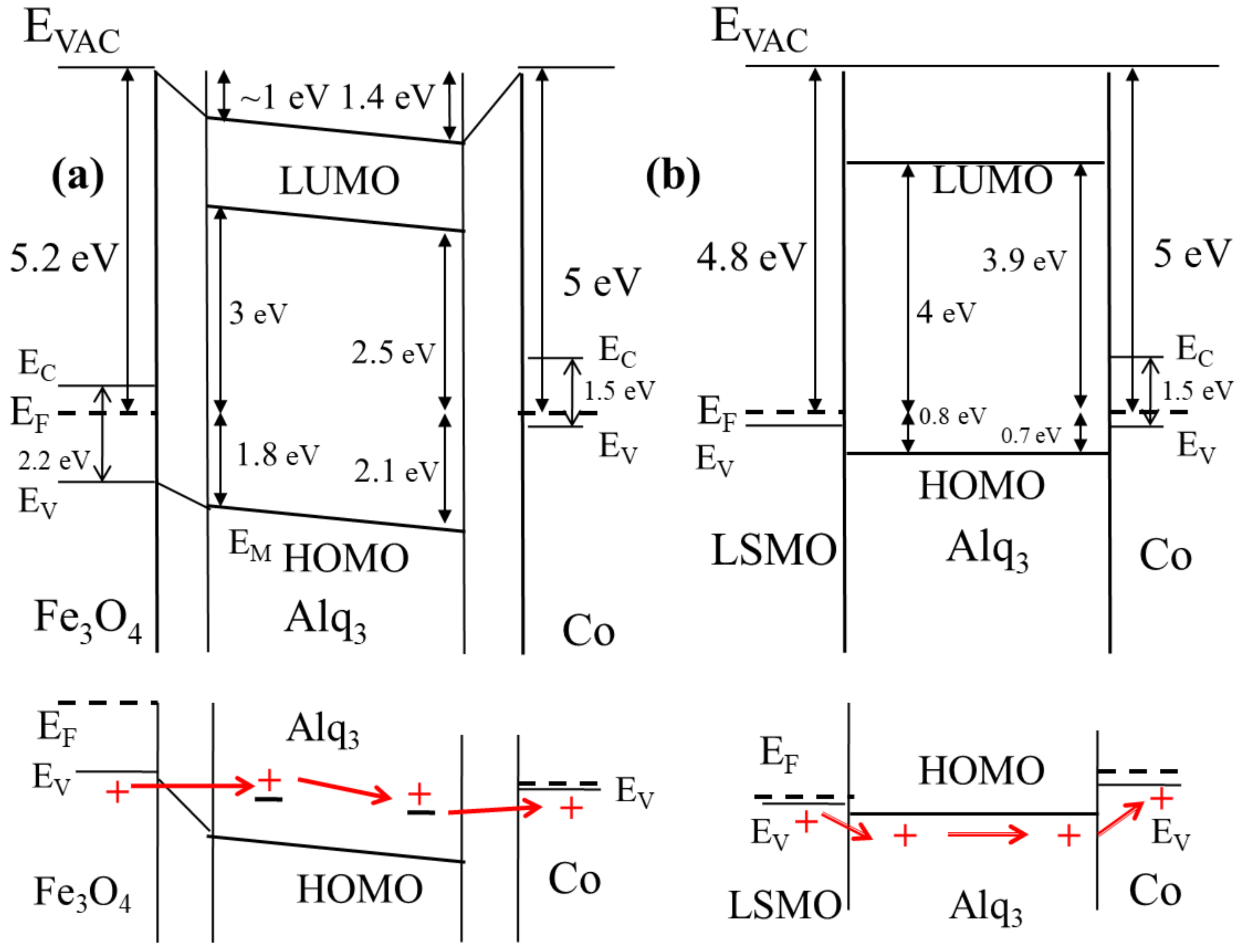Modeling of Spin Transport in Hybrid Magnetic Tunnel Junctions for Magnetic Recording Applications
Abstract
:1. Introduction
2. Device Structure
3. Modeling and Assumptions
4. Results and Discussion
5. Conclusions
Author Contributions
Funding
Data Availability Statement
Conflicts of Interest
References
- Datta, D.; Behin-Aein, B.; Datta, S.; Salahuddin, S. Voltage Asymmetry of Spin-Transfer Torques. IEEE Trans. Nanotechnol. 2011, 11, 261–272. [Google Scholar] [CrossRef] [Green Version]
- Dincer, O.; Naeemi, A. Spin Transport Modeling Tool. 2017. Available online: https://nanohub.org/resources/spintransport (accessed on 25 August 2022).
- Park, H.; Shin, D.-S.; Yu, H.-S.; Chae, H.-B. Electron mobility in tris (8-hydroxyquinoline) aluminum (Alq3) films by transient electroluminescence from single layer organic light emitting diodes. Appl. Phys. Lett. 2007, 90, 202103. [Google Scholar] [CrossRef]
- Halls, M.D.; Schlegel, H.B. Molecular Orbital Study of the First Excited State of the OLED Material Tris (8-hydroxyquinoline) aluminum (III). Chem. Mater. 2001, 13, 2632–2640. [Google Scholar] [CrossRef]
- Sito, J.; Grodzicki, M.; Lament, K.; Wasielewski, R.; Mazur, P.; Ciszewski, A. Electronic Properties of Structures Containing Films of Alq3 and LiBr Deposited on Si (111) Crystal. Acta Phys. Pol. A 2017, 132, 357–359. [Google Scholar] [CrossRef]
- Fong, H.H.; So, S.K. Hole transporting properties of tris (8-hydroxyquinoline) aluminum Alq3. J. Appl. Phys. 2006, 100, 094502. [Google Scholar] [CrossRef]
- Rashid, A.N.; Craig, D.C. Growth and Crystal Structure of Alq3 Single Crystals. A new structure showing π-π and CH-π interactions. Mrs Online Proc. Libr. 2004, 829, 393–401. [Google Scholar] [CrossRef]
- Groves, C. Simulating charge transport in organic semiconductors and devices: A review. Rep. Prog. Phys. 2016, 80, 026502. [Google Scholar] [CrossRef] [PubMed] [Green Version]
- Kanchibotla, B.; Pramanik, S.; Bandyopadhyay, S.; Cahay, M. Transverse spin relaxation time in organic molecules. Phys. Rev. B 2008, 78, 193306. [Google Scholar] [CrossRef] [Green Version]
- Bobbert, P.A.; Wagemans, W.; van Oost, F.W.A.; Koopmans, B.; Wohlgenannt, M. Theory for Spin Diffusion in Disordered Organic Semiconductors. Phys. Rev. Lett. 2009, 102, 156604. [Google Scholar] [CrossRef] [PubMed] [Green Version]
- Liu, H.; Valentin, C.D. Band Gap in Magnetite above Verwey Temperature Induced by Symmetry Breaking. J. Phys. Chem. C 2017, 121, 25736. [Google Scholar] [CrossRef]
- Bhatt, M.A.; Bhatt, P.J. Comparative analysis of dielectric strength and electron velocity in transformer oil based nanofluid. J. Eng. Sci. Technol. 2021, 16, 1167–1182. [Google Scholar]
- Brojabasi, S.; Muthukumaran, T.; Laskar, J.M.; Philip, J. The effect of suspended Fe3O4 nanoparticle size on magneto-optical properties of ferrofluids. Opt. Commun. 2014, 336, 278–285. [Google Scholar] [CrossRef]
- Deb, D.; Dey, P. Modeling of Temperature-Dependent Sign Reversal of Magnetoresistance in 99.95% La0.7Sr0.3MnO3–0.05% Paraffin Wax Nanocomposite: The Role of Pinning Center at Intergrain Defect Site. Phys. Stat. Solid. B 2019, 257, 1900402. [Google Scholar] [CrossRef]
- Deb, D.; Dey, P.; Choudhary, R.J.; Rawat, R.; Banerjee, A. Temperature dependent transition of conduction mechanism from carrier injection to multistep tunneling in Fe3O4 (111)/Alq3/Co organic spin valve. Org. Electron. 2021, 99, 106324. [Google Scholar] [CrossRef]
- Ganguly, S.; Datta, D.; Shang, C.; Ramadas, S.; Salahuddin, S.; Datta, S. Magnetic Tunnel Junction Lab. 2014. Available online: https://nanohub.org/resources/mtjlab (accessed on 25 August 2022).
- Barati, E.; Cinal, M.; Edwards, D.M.; Umerski, A. Gilbert damping in magnetic layered systems. Phys. Rev. B 2014, 90, 014420. [Google Scholar] [CrossRef] [Green Version]
- Liang, S.; Geng, R.; Yang, B.; Zhao, W.; Subedi, R.C.; Li, X.; Han, X.; Nguyen, T.D. Curvature-enhanced Spin-orbit Coupling and Spinterface Effect in Fullerene-based Spin Valves. Sci. Rep. 2016, 6, 19461. [Google Scholar] [CrossRef] [PubMed] [Green Version]
- Wang, F.; Vardeny, Z.V. Organic spin valves: The first organic spintronics devices. J. Mater. Chem. 2008, 19, 1685–1690. [Google Scholar] [CrossRef]
- Deb, D.; Nath, D.; Choudhary, R.J.; Roy, J.N.; Dey, P. Magneto-tunable photoresponse in ZnO-rGO/La0.7Sr0.3MnO3/ITO heterostructure: An opto-spintronic phenomenon. Phys. Lett. A 2022, 446, 128271. [Google Scholar] [CrossRef]
- Zhang, Q.; Chan, K.S.; Li, J. Spin-transfer torque generated in graphene based topological insulator heterostructures. Sci. Rep. 2018, 8, 434. [Google Scholar] [CrossRef] [PubMed]
- Devkota, J.; Geng, R.; Subedi, R.C.; Nguyen, T.D. Organic Spin Valves: A Review. Adv. Funct. Mater. 2016, 26, 3881–3898. [Google Scholar] [CrossRef]
- Tobin, J.G.; Morton, S.A.; Yu, S.W.; Waddill, G.D.; Schuller, I.K.; Chambers, S.A. Spin resolved photoelectron spectroscopy of Fe3O4: The case against half-metallicity. J. Phys. Condens. Matter. 2007, 19, 315218. [Google Scholar] [CrossRef] [PubMed]
- Dey, P.; Nath, T.K. Effect of grain size modulation on the magneto-and electronic-transport properties of La0.7Ca0.3MnO3 nanoparticles: The role of spin-polarized tunneling at the enhanced grain surface. Phys. Rev. B 2006, 73, 214425. [Google Scholar] [CrossRef]
- Bruno, F.Y.; Grisolia, M.N.; Visani, C.; Valencia, S.; Varela, M.; Abrudan, R.; Tornos, J.; Rivera-Calzada, A.; Unal, A.A.; Pennycook, S.J.; et al. Insight into spin transport in oxide heterostructures from interface-resolved magnetic mapping. Nat. Commun. 2015, 6, 6306. [Google Scholar] [CrossRef] [PubMed] [Green Version]
- Madon, B.; Kang, H.B.; Kang, M.G.; Maurya, D.; Magill, B.A.; Alves, M.J.P.; Wehrowe, J.-E.; Drouhin, H.-J.; Priya, S.; Khodaparast, G.A. Room temperature ferromagnetic resonance in hetero-epitaxial BTO-BFO/LSMO magnetoelectric composite. AIP Adv. 2018, 8, 105034. [Google Scholar] [CrossRef] [Green Version]
- Xiong, Z.H.; Wu, D.; Vardeny, Z.V.; Shi, J. Giant magnetoresistance in organic spin-valves. Nature 2004, 427, 821–824. [Google Scholar] [CrossRef] [PubMed]
- Yang, X.; Guo, A.; Guo, L.; Liu, Y.; Sun, X.; Guo, Y. Organic Semiconductors for Room-Temperature Spin Valves. ACS Mater. Lett. 2022, 4, 805–814. [Google Scholar] [CrossRef]
- Majumdar, S.; Majumdar, H.S. Decay in spin diffusion length with temperature in organic semiconductors—An insight of possible mechanisms. Synth. Met. 2013, 173, 26–30. [Google Scholar] [CrossRef]
- Jang, H.-J.; Richter, C.A. Organic Spin-Valves and Beyond: Spin Injection and Transport in Organic Semiconductors and the Effect of Interfacial Engineering. Adv. Mater. 2016, 29, 1602739. [Google Scholar] [CrossRef] [PubMed]
- Poggini, L.; Cucinotta, G.; Pradipto, A.-M.; Scarrozza, M.; Barone, P.; Caneschi, A.; Graziosi, P.; Calbucci, M.; Cecchini, R.; Dediu, V.A.; et al. An Organic Spin Valve Embedding a Self-Assembled Monolayer of Organic Radicals. Adv. Mater. Interfaces 2016, 3, 1500855. [Google Scholar] [CrossRef]
- Van Schijndel, M.J.M. Novel Experimental and Modeling Approaches to Organic Spin-Valves. Master’s Thesis, University of Technology, Eindhoven, The Netherlands, 2010. [Google Scholar]
- Shi, S. Theory and Modeling for Organic Spintronics and Electronics. Ph.D. Thesis, University of Minnesota, Minneapolis, MN, USA, 2017. [Google Scholar]
- Goswami, A.; Yunus, M.; Ruden, P.P.; Smith, D.L. Magneto-resistance of organic spin valves due to spin-polarized tunnel injection and extraction of charge carriers. J. Appl. Phys. 2012, 111, 034505. [Google Scholar] [CrossRef]
- Lian, H.; Cheng, X.; Hao, H.; Han, J.; Lau, M.-T.; Li, Z.; Zhou, Z.; Dong, O.; Wong, W.-Y. Metal-containing organic compounds for memory and data storage applications. Chem. Soc. Rev. 2022, 51, 1926–1982. [Google Scholar] [CrossRef] [PubMed]
- Lin, H.; Luo, X.; Liu, L.; Wang, D.; Zhao, X.; Wang, Z.; Xue, X.; Zhang, F.; Xing, G. All-Electrical Control of Compact SOT-MRAM: Toward Highly Efficient and Reliable Non-Volatile In-Memory Computing. Micromachines 2022, 13, 319. [Google Scholar] [CrossRef] [PubMed]
- Rakheja, S.; Chang, S.-C.; Naeemi, A. Impact of Dimensional Scaling and Size Effects on Spin Transport in Copper and Aluminum Interconnects. IEEE Trans. Electron. Devices 2013, 60, 3913–3919. [Google Scholar] [CrossRef]
- Sharkas, K.; Pritchard, B.; Autschbach, J. Effects from Spin–Orbit Coupling on Electron-Nucleus Hyperfine Coupling Calculated at the Restricted Active Space Level for Kramers Doublet. J. Chem. Theory Comput. 2014, 11, 538–549. [Google Scholar] [CrossRef] [PubMed]
- Yang, Y.; Geng, H.; Yin, S.; Shuai, Z.; Peng, J. First-principle Band Structure Calculations of Tris(8-hydroxyquinolinato) aluminum. J. Phys. Chem. B 2006, 110, 3180–3184. [Google Scholar] [CrossRef] [PubMed]
- Droghetti, A.; Thielen, P.; Rungger, I.; Haag, N.; Gromann, N.; Stockl, J.; Stadtmuller, B.; Aeschlimann, M.; Sanvito, S.; Cinchetti, M. Dynamic spin filtering at the Co/Alq3 interface mediated by weakly coupled second layer molecules. Nat. Commun. 2016, 7, 12668. [Google Scholar] [CrossRef] [Green Version]




| Model Parameters | Alq | FeO |
|---|---|---|
| Fermi Energy Level (eV) | 4.8 | 5.2 |
| Bulk Mean Free Path (m) | 15.88 × 10 | 750 × 10 |
| Bulk Resistivity (ohm m) | 1 × 10 | 0.2 |
| Electron Density (m) | 2 × 10 | 5.8 × 10 |
| Fermi Velocity (m/s) | 1.2 × 10 | 1.1 × 10 |
| Spin Flip Probability (Phonons) | 0.1 | 0.4 |
| Spin Flip Probability (defects) | 7 × 10 | 1 × 10 |
| Grain Scattering Coefficient | 0.5 | 0.3 |
| Sidewall Scattering Coefficient | 0.1 | 0.08 |
| Model Parameters | Change with (Decreasing Temperature) | Deviation of MR (Decreasing Temperature) |
|---|---|---|
| Bulk Mean Free Path | Decrease | Decrease |
| Bulk Resistivity | Increase | Decrease |
| Electron Density | Decrease | Increase |
| Fermi Velocity (m/s) | Decrease | No change |
| Spin Flip Probability (Phonons) | Decrease | Increase |
| Spin Flip Probability (defects) | Increase | Decrease |
| Model Parameters | FeO Device | LSMO Device |
|---|---|---|
| Area of FeO/LSMO (nm) | 6400 | 6400 |
| Free Layer Co Thickness (nm) | 10 | 10 |
| Saturation Magnetization (M) | 90 | 750 |
| Damping Coefficient () | 0.01 | 0.02 |
| Easy axis anisotropic field (H, Oe) | 50 | 50 |
| Demagnetizing Field (H, Oe) | 1000 | 200 |
| Alq barrier height (eV) | 4.6 | 4.6 |
| Alq spacer effective mass | 0.16 | 0.16 |
| Spin split Fermi level for FeO/LSMO (eV) | 1.53 | 1.5 |
| FeO/LSMO effective mass | 0.38 | 0.32 |
| FeO/LSMO Fermi level (eV) | 5.2 | 5 |
Publisher’s Note: MDPI stays neutral with regard to jurisdictional claims in published maps and institutional affiliations. |
© 2022 by the authors. Licensee MDPI, Basel, Switzerland. This article is an open access article distributed under the terms and conditions of the Creative Commons Attribution (CC BY) license (https://creativecommons.org/licenses/by/4.0/).
Share and Cite
Deb, D.; Mahajan, B.K. Modeling of Spin Transport in Hybrid Magnetic Tunnel Junctions for Magnetic Recording Applications. Crystals 2022, 12, 1411. https://doi.org/10.3390/cryst12101411
Deb D, Mahajan BK. Modeling of Spin Transport in Hybrid Magnetic Tunnel Junctions for Magnetic Recording Applications. Crystals. 2022; 12(10):1411. https://doi.org/10.3390/cryst12101411
Chicago/Turabian StyleDeb, Debajit, and Bikram Kishore Mahajan. 2022. "Modeling of Spin Transport in Hybrid Magnetic Tunnel Junctions for Magnetic Recording Applications" Crystals 12, no. 10: 1411. https://doi.org/10.3390/cryst12101411





